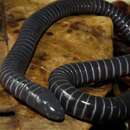Brief Summary
provided by IABIN
Diagnosis Large species reaching above 470 mm in length; primaries, approximately 102-117. No splenial teeth, the tongue fastened at tip; eye more or less distinct, in a socket, its orbit continuous with the tentacular groove; tentacle in front of and somewhat below eye, its distance from nostril more than three times as far as its distance from eye. Premaxillary-maxillary teeth, 14-14 to 16-16; prevomeropalatine teeth, 12-12 to 16-16; dentary, 9-9 to 14-14; preanal glands visible, at least in some males; vent somewhat Vshaped. Terminal part of body unsegmented. Color, slate, dark olive, or brownish, the grooves cream or yellowish below and on sides, and crossing over body posteriorly.
- author
- Esteban O. Lavilla
- editor
- Diego Arrieta
Distribution
provided by IABIN
Found in eastern, central, western and southern Brazil, northern Argentina (southern Misiones and northeastern Corrientes provinces), northeastern Paraguay and southeastern Bolivia.
- author
- Esteban O. Lavilla
- editor
- Diego Arrieta
Diagnostic Description
provided by IABIN
Adult morphology The head is short, the snout oval, the body plump, and subcylindrical. The eyes are rather indistinct but visible as grayish-white spots. They are 7 mm apart, a distance slightly greater than the length of the snout from the eye level to tip (6.8 mm). The tentacle is small, the groove surrounding it horseshoe-shaped, its diameter about 0.2 mm. Its distance from the edge of the eye (1.25 mm) is about one third its distance from the nostril, while its distance from the mouth is 1.4 mm. The snout projects beyond mouth 2.9 mm. Two distinct collars are present, the first distinct above and below with a transverse groove partially dividing it dorsally. The second collar likewise is distinct, also divided by a transverse groove. Following these collars are 117 primary folds or annuli, the last four incomplete above. These are followed by an unsegmented "shield" which has a length equal or nearly equal to the width of the body. The vent is somewhat V-shaped with six or seven denticulations behind, and two larger lobules in front, these parts bearing the anal glands (males). From the vent to the end of body, 4 mm; no scales and no secondaries are present. Dentition: The premaxillary-maxillary teeth are 15-1-15 (15-16) ; prevomeropalatine, 10-11 ; dentary, 11-11 ; splenial, 0-0. The dentary teeth are much the largest. The prevomeropalatine series are continuous, the prevomers, not separated mesially, are placed at a distinctly different level from the premaxillary-maxillary series. The subcircular choanae are directed forward, the diameter of one contained in the distance between them approximately three times. The tongue is plump and fused to the gums at its tip, lacking any trace of narial plugs. Color: The body generalIy is light slate above, the head olive-slate becoming a little lighter laterally and exhibiting certain shades of brownish violet slate. The underside of the terminal part of the body is yellowish including the region about the vent. A small discrete white spot precedes the eye and is separate from a yellowish spot above tentacle. A cream spot precedes the nostril. Variation Some specimens shows a variation in the number of annuli following the collars of from 101 to 118. Remarks on the lecotype: there are 109 annuli following the collars; the three final ones before the "shield" are incomplete dorsally; no scales are present. Premaxillary-maxillary teeth, 15-15, rather large; prevomeropalatine, 13-13; dentary, 14-14, larger than upper teeth; no splenials. The eye is in a socket which is continuous with the tentacular groove. The tongue is attached anteriorly and the choanae are rather rounded and directed forward. The collars are each partially divided transversely by a groove on the dorsal surface. The measurements in mm are: eye to tentacle, 0.8; eye to lip, 1.2; to nostril, 3.8; between eyes, 8.3; eye level to snout-tip, 5; width of head, 10.8; width of body, 152 ; total length, 4-3; width in length, circa 27 times. The color is dark olive above, a somewhat different shade on venter. The grooves on the venter and sides are whitish or cream (including those of the collars), not crossing dorsum very distinctly except posteriorly; no yellow spot is present on vent, but the area is brownish. Anal area especially brown with a rough surface (not shiny); the skin glandules have angular, rather than circular, outlines.
- author
- Esteban O. Lavilla
- editor
- Diego Arrieta
Siphonops paulensis: Brief Summary
provided by wikipedia EN
Siphonops paulensis, or Boettger's caecilian, is a species of caecilian in the family Siphonopidae. It is found in northern Argentina, Paraguay, eastern Bolivia, and southern Brazil. It lives subterraneously in forests, savannas, shrublands, and grassland. It also adapts to anthropogenic disturbance and can even live in urban gardens. In fact these caecilians have even been recorded to breed and raise their young close to Santa Cruz, a highly populated city. It is a locally common species that is not facing major threats.
- license
- cc-by-sa-3.0
- copyright
- Wikipedia authors and editors

